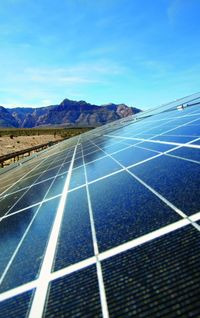Green data centres are quickly becoming the standard and not the exception in an industry increasingly catching the eye of investors. Robert White, managing director, head of green & sustainable hub – Americas, Natixis CIB outlines the sustainability issues surrounding an emerging asset class in an interview with PFI
The data centre industry has been on a rapid growth trajectory in recent years but, until recently, it has remained largely under the radar from a sustainability perspective and for investors. As businesses migrated their digital assets and IT resources and services into the cloud, computing has moved from a couple of racks in dusty rooms on-site in the office into much larger, dedicated purpose-built facilities off-site. With that move came an improvement in overall energy performance.
“Energy efficiency improved, even though the volume of data being crunched by the global economy kept increasing,” said White. “So, while demand for computing grew exponentially, total energy demand has been creeping up in a more linear fashion, and not at a scale that was really driving too much of any material concern from a green viewpoint. Neither was it of a scale to be seen as a major asset class within the finance community.”
Many of these facilities were financed in-house within the data centre operators, but also within the hyperscalers, such as Amazon and Microsoft. That is changing. Growth in demand for compute in the cloud would have been likely to remain impressive but additional demand is anticipated to come from AI and the energy intensive training of AI. “We're now in a world where energy demand is expected to increase even more, even faster,” said White.
According to Goldman Sachs, data centres represent about 3% of US electricity demand. By 2030 they're forecast to be 8% of total US electricity demand. In Ireland, data centres consumed 21% of metered electricity in 2023, according to the Central Statistics Office. In 2015, it was 5% and in 2022 it was 18%.
“In response, the average size of data centres is ramping up,” said White. “Just a couple of years ago, data centres were 20MW to 50MW in size, and now we're regularly seeing campuses of 350MW to 400MW being rolled out in stages. We’re also seeing discussions for 1GW campuses.”
With that kind of scale and consequent draw on energy, concerns around funding and sustainability are rising.
Cooling concerns
“Increasingly, the investor community is wanting access to information on a wider range of data sets, so it’s helpful to think about the main drivers around date centre energy consumption,” said White. “One is cooling, because cooling can represent around 40% of total power consumption.”
Questions around cooling include the use of refrigerant gases and their global warming potential. That’s most evident in Europe, according to White, due to there being a threshold in the EU taxonomy for refrigerant gases to be considered eligible. “Typical cooling gas today has a global warming potential (GWP) in the 1,200–1,400 range, you need a much lower GWP of 675 to be compliant with the taxonomy,” he said.
That points to a supply chain issue, as sourcing low GWP refrigerant gas is difficult. “The US supply chain needs to pivot to be able to deliver these gases,” said White. “There’s also an installation and design issue as a lot of lower GWP gases can be more flammable.”
Adding water
Access to water is another major concern to investors as data centres are water intensive. Some estimates point to hyperscale data centres consuming 200 million gallons of water per year for their cooling systems and other operations. Environmental issues are a major social aspect for sustainable investors, particularly when centres might compete for already restricted water supplies, such as those regions susceptible to drought or in densely populated urban areas.
Again, that is changing. “Traditional cooling methods used evaporative air cooling, and were therefore sucking up endless amounts of water,” said White. “A lot of the new data centres that we're financing will use closed loop technology. Once charged up in a closed loop, then you're not consuming anywhere near the same level of water. The water usage efficiency effectively drops to zero.” Using closed loop, waterless technologies will enable data centres to be placed in regions where previously they might have met community resistance.
A lot of noise
Other social considerations have also started to surface, such as noise. It’s another concern that sustainable investors, particularly in Europe, are placing greater emphasis on understanding how noise is being managed.
“You can experience continuous noise levels above 90 decibels (dB),” said White. In the UK, the level at which employers must provide hearing protection is 85dB. “Permanent exposure to that level of noise is problematic,” he said. “We have seen cases where community resistance to already approved data centres have caused developers to discontinue plans altogether or go back and retrofit in an effort to bring down noise levels.”
Energy efficiency
Improving the efficiency of energy in data centres is another area of interest for green investors. The main metric used is power usage effectiveness (PUE), but there are a range of views on what the target should be.
“From a green perspective, we want to understand what can be considered an efficient PUE,” according to White. “The market is currently settling on a best-in-class number of around 1.5 PUE for green data centres – the global average is currently 1.55. “We [Natixis] don't think that's robust enough – and from our own surveys, investors say a PUE of 1.5 is not sufficient to be considered green,” said White.
In the US, Natixis is looking at a PUE of 1.4 for data centres to join the top 15% of best-in-class operators.
“We're also seeing some of the latest and greatest new builds come in with a PUE as low as 1.15,” said White. “That includes a deal we’re working [on] at the moment and is going through syndication.”
Even as efficiency improves and PUE tends towards one, it will not account for the major energy consumer in data centres: the compute. “Computing efficiency is the next question that needs to be addressed. We need a measure of efficiency for compute,” said White. “We can't just keep consuming more energy and expect power to just magically keep appearing.” Nevertheless, the digitisation of the economy is pressing ahead and the wider adoption of AI is going to require even more power. Demand for energy is set to grow at pace in absolute terms.
Access to power
While improving the energy efficiency of data centres is a key concern, there are also social issues regarding access to power. “It's one thing to put a 20MW data centre somewhere on the local grid – it looks little more than a storage facility and no one bats an eyelid,” said White. “You drop a 500MW energy consuming data centre in a local grid and that can cause problems.”
The impact from hooking up a large-scale data centre on local transmission and distribution lines is significant. “Distribution lines will need upgrading. Substations will need upgrading. How does that get paid for?” asked White. “And what does that do to the regulated asset base? Does it have a negative impact on the local community? Will bills go up? What benefit do they see?”
Electricity grid operators are reaching a position where they have little capacity to accommodate data centre build. Ireland’s operator, EirGrid, said it will not connect any more data centres in Dublin until 2028. It has led to hyperscale data centre operators moving to build their own distribution lines.
In the meantime, data centres still need to feed their power-hungry operations. A new survey released by KPMG revealed that some operators are prepared to pay 50% more for power just to get it and if it's green energy, then up to 100% more.
The appetite for green energy reflects the sustainability commitments of the hyperscalers, so where the power comes from is a question that cannot be ignored. It needs to come from a renewable or clean source. “Those who were previously just talking in terms of renewable energy have shifted their language over to clean energy,” said White. “Because they want to include nuclear power. Nuclear is very much back as an option.”
Sustainable finance
Reflecting its "growth" status as an asset class, most of the data centre financing to date has been at the bank level. “We still see individual project by project construction finance, but we're also seeing a number of data centre operators set up devco financing, where they seed a portfolio with a number of existing assets that are moving through construction,” said White.
As assets are constructed and the data centres attract long-term tenants, then they will be ready for a takeout. That is when the focus will shift more to the capital markets. That is not to say there has been no capital markets activity. Data centre dedicated REITs have been to the markets for financing, there have been deals in the ABS space and also issuance in the US private placement market.
“We’re seeing capital being recycled into a number of markets depending on the size, the configuration, whether it’s a single data centre, or a portfolio,” said White.
A layer for green can also be applied to the vanilla financing landscape. “Sustainability-linked loans work well for a devco/holdco piece, because assets are moving in and out,” said White. “You can put metrics in place to ensure that the sustainability of data centres improves over time.”
Key performance targets on some of the SLLs on which Natixis has been involved include PUE, renewable energy procurement and water consumption. Targets are tailored to reflect the age and mix of assets in the portfolio and, for instance, the renewable energy procurement strategy.
“Operational PUE can be a really good target for KPI monitoring,” said White. “New data centres will be designed to reach a specified PUE. But will it actually do what it's designed to do? Measuring operational PUE against the design can become a really nice metric when you're looking across a portfolio.”
So, for data centre operators with hyperscale tenants and multi tenanted co-locators, finance is currently provided by the bank market through sustainability-linked lending, but when the market reaches the capital markets' term-out stage, then White expects to see more use-of-proceeds green financing in the bond markets.
“Then it will be about identifying those assets that are best in class, that can articulate a strong PUE, that water is managed appropriately, that there is a renewable energy strategy or clean energy strategy in place,” he said. “They’re going to be the key pieces. The ones that can then unlock additional liquidity and differentiation.”
Tapping the capital markets brings in a new range of investors and helps recycle liquidity. “There are a number of Article 8 and 9 investors in Europe that can look at data centres through their infrastructure funds, through a real estate or impact fund lens,” said White. “And if you can bring the green format with the right metrics then that adds another level of participation.”
To see the digital version of this report, please click here.
To purchase printed copies or a PDF of this report, please email leonie.welss@lseg.com














